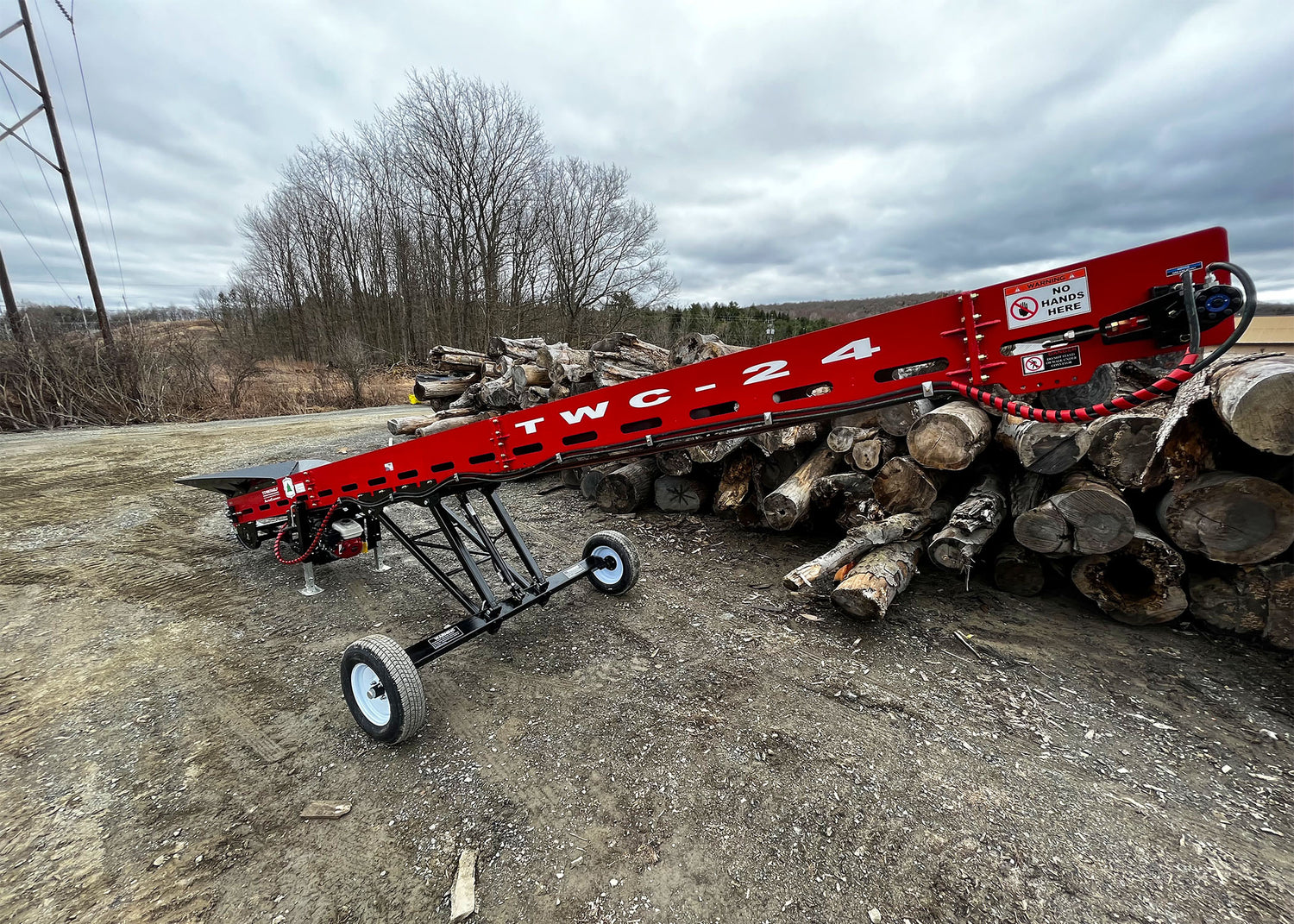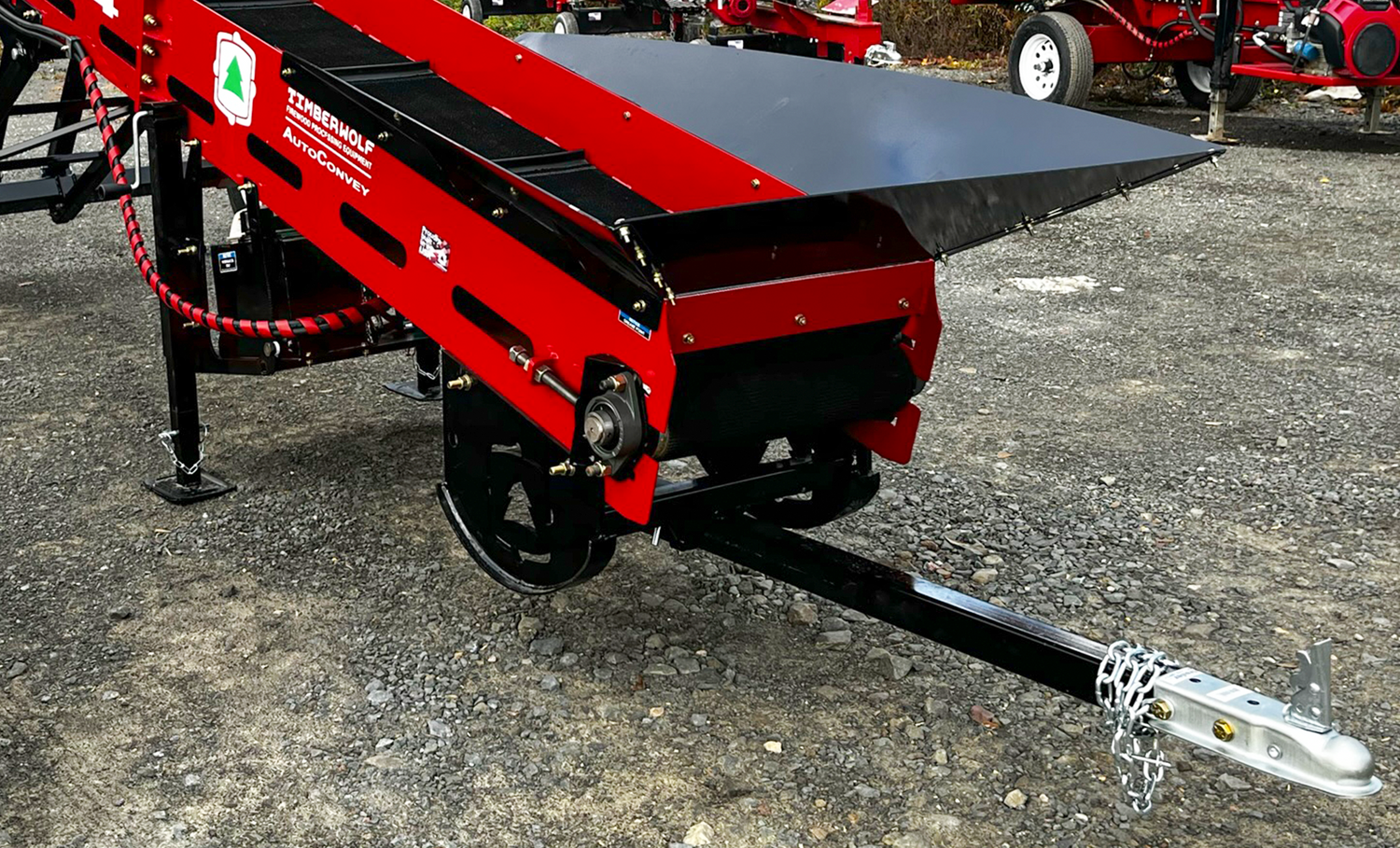Comparing Chain and Belt Conveyors for Biomass Handling
In biomass operations—particularly those involving firewood—choosing the right conveyor system is crucial for efficiency, durability, and cost-effectiveness. Chain and belt conveyors (including paddle belt and rough top belts) are widely-used methods for moving biomass, each type suited for a variety of processes. Understanding the similarities, differences, and applications of these systems can help operators make informed decisions when it comes to purchasing a conveyor of their own. Timberwolf customers frequently recommend investing in a wood conveyor prior to upgrading their log splitter, as they have an incredible ability to boost productivity (and profit!).
🔗 Chain Conveyors: Robust and Versatile
Chain conveyors are known for their strength and reliability, making them suitable for handling heavy or abrasive materials. They are particularly effective in environments where durability is paramount.(hustlerequipment.com)
Key Features:
- Durability: Designed to withstand harsh conditions, chain conveyors are less susceptible to damage from heavy or abrasive materials.
- Maintenance: While robust, chain conveyors may require more maintenance due to the wear and tear on chains and sprockets.
🟠 Belt Conveyors: Efficient and Clean
Belt conveyors are favored for their smooth operation and ability to handle a variety of materials gently. They are ideal for applications where cleanliness and minimal maintenance are priorities.
Key Features:
- Smooth Operation: Belt conveyors provide a continuous surface, reducing the risk of material spillage and ensuring a clean operation.
- Maintenance: Generally, belt conveyors require less maintenance compared to chain systems, though belt wear and tracking issues can occur. Timberwolf conveyors have solved this frustrating issue with their self-adjusting tapered rollers for correct belt tracking. Learn more about this feature here.

Belt Options:
All Timberwolf biomass conveyors come equipped with a rugged and tough paddle belt. A paddle belt conveyor offers several advantages over a rough top conveyor, particularly in high-volume firewood and biomass operations. The primary benefit lies in its ability to move irregularly shaped or uneven materials more efficiently; the evenly spaced paddles physically push material along the belt, reducing slippage and ensuring consistent flow even on steeper inclines. This design is especially useful when handling bulky or wet firewood, which might not grip well on a standard rough top surface. In contrast, a rough top belt relies on surface friction to transport materials, which can be less effective under variable load conditions or with debris buildup. Paddle belts also help minimize material fallback and can improve overall throughput and reliability in demanding environments.

Timberwolf Models:
- TWC-12: The smallest in Timberwolf's lineup, the TWC-12 features a 12-foot frame and is powered by a 4.9 HP Honda engine. It offers a maximum height of 8' 9" and includes features like funnel-like hopper for easy transportation from the log splitter to the firewood elevator and a hydraulic lift cylinder for effortless height adjustments. (Timberwolf Firewood Processing Equipment)
- TWC-16: A medium-height conveyor suitable for firewood businesses large and small, the TWC-16 has a maximum working height of 10', a minimum working height of 7'9", and a travel height of 7'. At its full functioning height, the firewood conveyor can store a huge stack of seasonal firewood, and at its lowest working height, it can load the bed of a pickup truck. (Timberline)
- TWC-24: This 24-foot conveyor is equipped with a rough top belt and offers a maximum height of 13' 2". It also features tapered rollers and a ground skid for added stability. Because of the wood elevator’s size, it uses telescopic axle arms, which are two arms on either side of the hydraulic lift cylinder. The telescopic axle arms provide a sturdy firewood conveyor base, dramatically reducing the risk of the conveyor tipping, and allow for simple height adjustment. (Agriculture XPRT)
-
TWC-32: Weighing 2,040 pounds with a frame length of 32’, the TWC-32 is our largest firewood conveyor model, perfect for large-scale commercial projects that need a boost in productivity. This conveyor can reach heights up to 14'1" and caters to various material handling needs. (Lumbermen Online)
- 36” long Grizzly Bars can be added to the TWC-32 wood conveyor. This optional add-on bolts onto the end of the conveyor and cleans out fine material from your firewood before it is offloaded.
- The wood elevator can optionally be constructed with an oscillating axle that allows the TWC-32 to move side-to-side, either via a manual adjustment or driven roller.

⚖️ Comparison Overview
| Feature | Chain Conveyors | Belt Conveyors |
|---|---|---|
| Durability | High | High |
| Maintenance | Higher due to chain wear | Lower |
| Material Handling | Suitable for heavy/abrasive materials | Ideal for clean, gentle handling |
| Cost | Generally lower initial cost | Higher initial cost, but lower maintenance |
| Applications | Silage, heavy logs | Firewood, clean biomass handling |
🛠️ Conclusion
The choice between chain and belt conveyors depends on the specific needs of the biomass operation. For handling heavy or abrasive materials, chain conveyors offer durability and strength. For applications requiring clean and efficient material handling, belt conveyors such as the Timberwolf TWC-12, TWC-16, TWC-24, and TWC-32 provide smooth operation and lower maintenance. Timberwolf Equipment's diverse range of conveyors ensures that operators can find a solution tailored to their specific requirements.(Agriculture XPRT)
Get an instant quote for your own Timberwolf conveyor here. Unsure about which model will work the best for your business? Give us a call at (607) 307-4029 and our sales team will be happy to assist in your purchasing journey.
